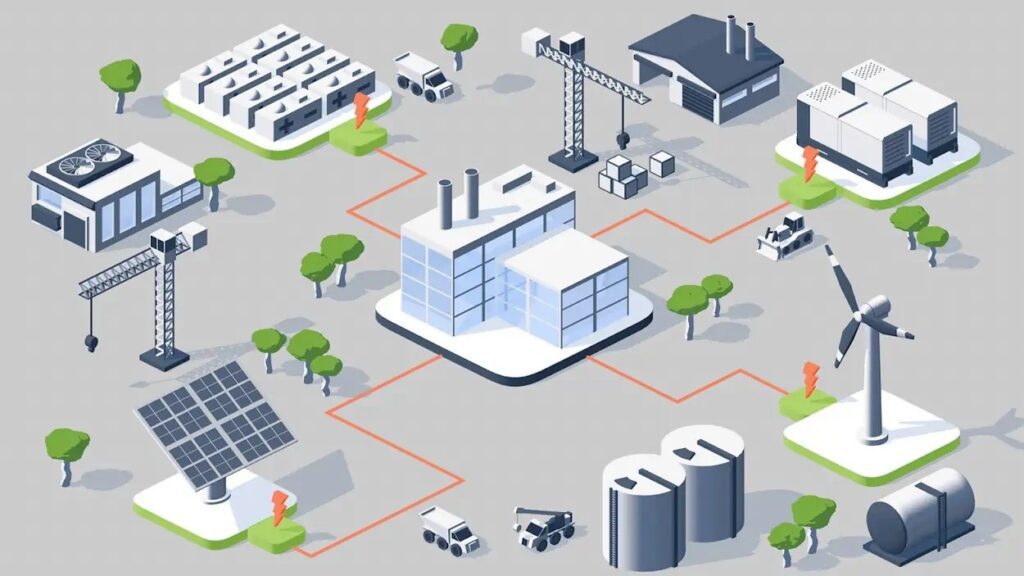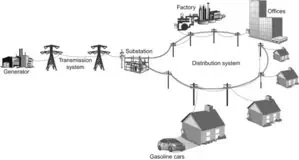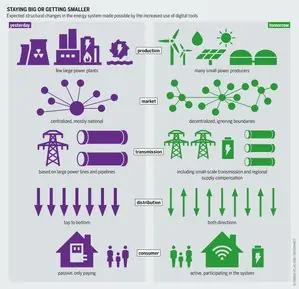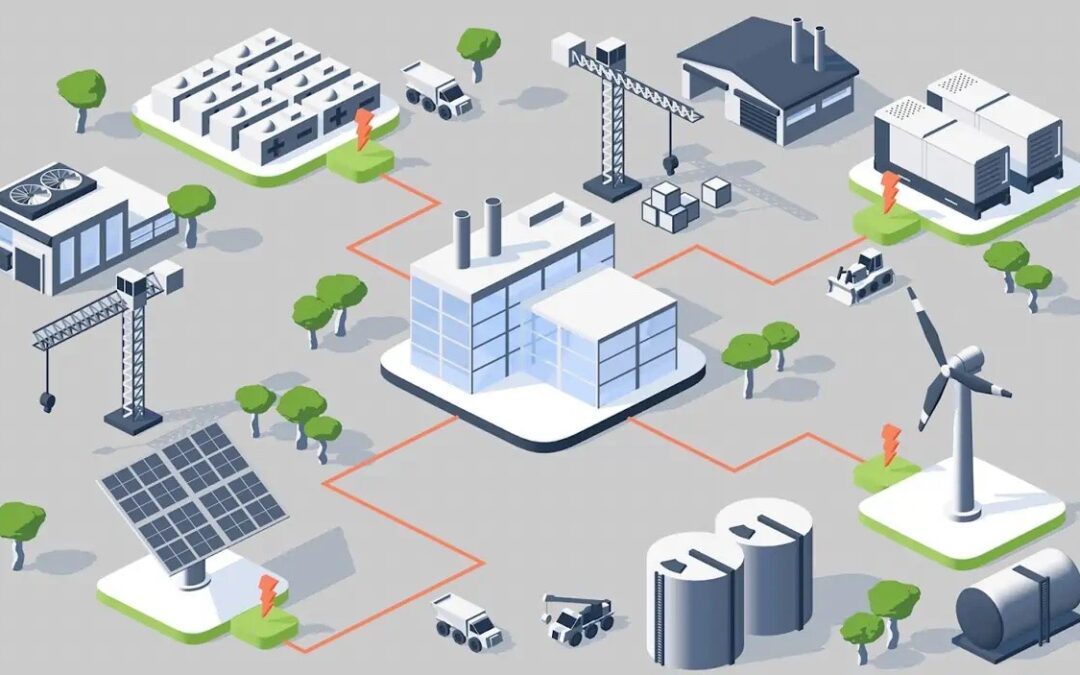The web has come a long way since its inception in 1989. From Web1 to Web2 to the current transition to Web3 – the internet has seen many changes. In the last article we explored Web2 and in this article we will look into how the existing energy grid is making the transition from a Web1 to Web2 world.

As a reminder, Web2 is when the internet started to become more interactive. Web applications are no longer just about consuming information – they now allow users to interact with each other and create new content. This shift has given rise to a whole host of new platforms and services that became “data aggregators”.
What is the traditional grid – Web 1

The energy sector is a vital component to our society. The traditional energy grid is a network of power lines that delivers electricity to homes and businesses. The grid is made up of generators, transmission lines, transformers, and distribution lines.
Generators (typically located far from the consumption base) create electrical power, while transmission lines carry the power from the generator to the transformers. Transformers change the voltage of the electrical power so it can be used by businesses and homes. Distribution lines then carry the power from the transformer to the customer.
The economy, national security and even the health and safety of countries citizens depend on the reliable delivery of electricity. For context, the U.S. electric grid has more than 9,200 electric generating units, more than 1 million megawatts of generating capacity connected by more than 600,000 miles of transmission lines.
A Smarter Grid – Web 2
As previously discussed, the grid is aging and it is being pushed to do more than it was originally designed to do. Modernizing the grid to a Web2 world and making it “smarter” is underway through the use of technologies, equipment, and controls that communicate and work together with the intent to deliver electricity more reliably and efficiently.
It can reduce the frequency and duration of power outages, reduce weather event impacts, and enable the restoration of services faster when outages occur (that said, with all the technology in the world, it is hard to protect the centralized grid from severe weather events). Further, a smarter grid is one that is no longer centralized and unidirectional, plant to consumer, a smarter grid enables the consumer to have more control and more access.
A smarter grid
To achieve this, sensors and communication (2-way between the provider and the consumer) and control systems have been and are being deployed. This advancement allows utilities and operators to more proactively assess grid stability, assess and recover faults and re-route power around problems.
On the consumer side (business and residential) we have the ability to install our own distributed energy solutions, smart meters and smart appliances that track usage and allow for enhanced communication, interaction and control. The primary differences between the traditional power grid and a smart grid are as follows:
- Technology – transitioning from mechanical devices that are electrically operated with no means of 2-way comms to a digitally enabled technology that allows for remote control and self-regulation of devices.
- Generation – in a traditional grid design all power is generated from one central source, while a smart grid can distribute power from multiple power sources and substations to balance loads.

- Distribution – single direction distribution from power source to consumer transitioning to a smart grid that enables companies/individuals with their own alternative energy sources (today this is primarily solar) can be put back into the grid and be compensated for it.
- Sensors & Monitoring – a smart grid has sensors throughout, enabling the operator to pinpoint and address problems, manage the grid to minimize outages/downtime and control the flow of energy. This can be done remotely and minimize the need for direct in-person interventions. The data ultimately should enable utilities and grid operators to have more rich data to manage their grid and enable more effective investment decisions as the utility can see where capital needs to be deployed and into what type of assets. In theory this should result in more cost-effective energy, that said the current commercial structure for utilities does not largely support this.
- Customer Choice and Alternative Energy Integration – a smarter grid enables both traditional and alternative energy sources to be integrated and operated. Ultimately enabling a more resilient and diverse solution and providing customers with more choice in the type of energy they receive for a particular price point. Consumers can also utilize their data to select tariff structures that are more commercially favorable to their energy use profile – which when designed right can align incentives – encouraging users to consume energy when it is more readily available, clean and cheap than when it is not.
- Data Aggregators and Alternative Commercial Models – As with Web 2 we are now starting to see new companies emerge with unique apps that are easy to use, interactive and have different commercial models. One such example of this is OhmConnect whereby consumers can be compensated for saving energy when the grid is “oversubscribed”, preventing the need to bring peaker units online – which can be expensive and less green than base load power. In the recent California heat wave when the state was close to blackouts, OhmConnect users reduced more than 1.5 gigawatt hours of electricity consumption and earned more than $2 million in cash and gift cards in the process. This is an awesome example of leveraging technology, gamification and aligned incentives to drive positive outcomes.
Pros and Cons
As with Web2 in our business and personal lives, there are pros and cons with a Web 2 Energy Sector:
Some Pros:
- Ease of use – The modernization of infrastructure and the deployment of smart meters combined with new apps/websites – consumers can now measure track and trend energy use, typically in hourly increments and in real-time allowing for informed decisions and access to new opportunities and commercial offerings.
- Convenience – We can make more informed decisions about how we optimize our use of energy from our smartphones and laptops in realtime, vs monthly paper based bills. It aslo means you no longer need someone coming to your house to read your meter manually, which was a privacy and security issue.
- Customized – The data and trends are our specific consumption data, not aggregated trends, allowing for users to utilize data that is customized to them. This data can then be used to manage energy use and select tariff structures which may align best with use profiles to manage costs. Further, it enables us to assess the opportunity for and the associated return on investment for deploying our own onsite energy solutions.
- Utility – in certain jurisdictions energy is still monopolized, while in others you can choose your energy provider like to can your internet/phone/tv provider – enabling you to shop for the best possible deal and one that aligns with your needs and objectives. Further, one can select different energy plans based on emission profiles – do you want to pay a premium for greener energy. Net metering is also enabled in Web2 energy – allowing those that produce more energy than they consume on their property to return the excess to the grid and be compensated for it (where allowed – utilities are fighting this as it impacts their profit margins).
With value creation comes challenges and risks that it is important to be aware of:
- Centralized Reliance & Reduced Transparency – With the deployment of this infrastructure utilities and operators now sit on mountain loads of data that can be leveraged to advance their commercial models, see below. That said, what i have seen throughout my career is that often the utilities do not know how to leverage this rich data, as we have witnessed with the “data aggregators” discussed in the last article, and it is costing them a fortune to store and maintain the data. They do not typically want to bring in external vendors and give them access to the data as the best energy traders are those who know what is happening now, with this data and their own technology, they would be able to disrupt the business models of the utilities/operators and perform the role more efficiently. This is limiting value for customers today.
- Reliability and Security – the centralization of data and power can lead to data breaches, security issues or just reliability challenges. Centralized systems often create a single point of failure and a single decision point, see power and control next – this is true for todays energy market and then way it is managed.
- Power & Control – As a result of the centralization of data to utilities and operators, this provides them with so much power that is very hard to manage. For instance, the utilities in the energy market (particularly the regulated markets) can really at any time:
- Determine whether you receive energy or not. We have seen this extensively in California with the Power Safety Shut Offs, where a utility for fears of weather-related safety issues can cut off power to consumers for as long as is needed at huge operational costs to businesses and on a personal level – safety/cost/lifestryle disruptions.
- Determine how the energy is produced – coal, gas, nuclear, renewables – for the most part as consumers of enegry from utilities we have no control over where it comes from or how it is produced.
- Costs – we are seeing escalating energy costs globally. The cost to produce, maintain and distribute energy is becoming increasingly expensive with the current infrastructure models. Utilities with the use of our consumption data can manipulate tariffs and rates to ensure their business models are as profitable as possible. Further the data can be leveraged to block industry developments such as net metering, more distributed and onsite energy solutions, new commercial models technology and more.
The energy industry has really only just begun to scratch the surface of what is possible with the technologies available today and there is a huge amount that can be learned from how the Web2 opportunities have been applied to other sectors. In the next article, we will explore how as businesses we can maximize the current Web 2 energy environment and ultimately position for a Web3 world. Follow us here and keep an eye out for the next blog.
